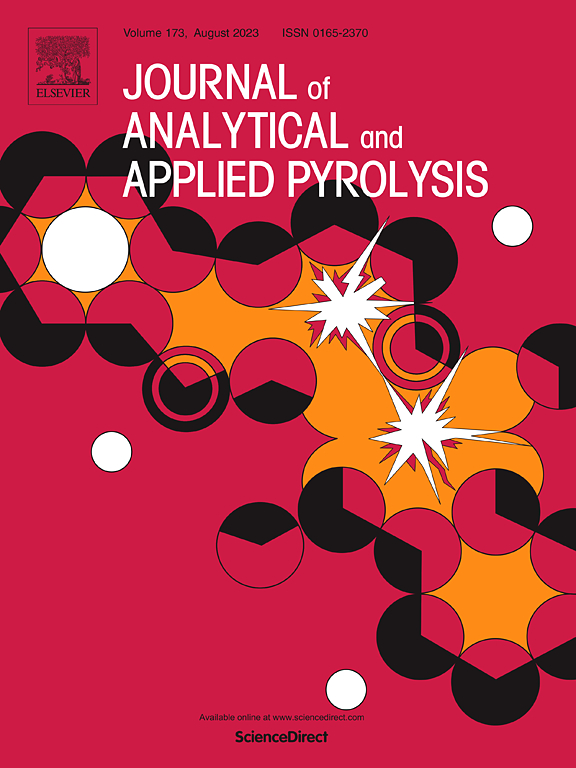γ-Al2O3负载NiO/CoO下微波催化普通小球藻和废轮胎共热解特性、产物分析及反应机理
IF 6.2
2区 化学
Q1 CHEMISTRY, ANALYTICAL
引用次数: 0
摘要
催化剂有效促进加氢脱氧和反硝化,提高热解液质量。通过在γ-Al2O3上分别负载NiO/CoO,制备了X@γ-Al2O3 (X = NiO, CoO)催化剂。研究了不同添加量(相对于原料10 wt%、20 wt%、30 wt%)的X@γ-Al2O3对普通小球藻(CV)和废轮胎(wt)微波共热解的影响。X@γ-Al2O3改善了CV和WT的共热解特性,但不同的金属活性中心导致了不同的催化性能。与CV: WT= 6:4(记为C6W4)相比,30 WT % NiO@γ-Al2O3对热解特性的催化效果最好,平均失重速率最大(0.01952 WT %/s),最大失重速率为0.05752 WT %/s。相反,当co @γ- al2o3添加量超过10 wt%时,大量的碳沉积使许多催化位点失活,导致催化性能下降。与C6W4相比,X@γ-Al2O3作用下的液收率降低了4.40 % ~ 10.37 %,气收率提高了4.71 % ~ 11.61 %。在10 wt% CoO@γ-Al2O3和30 wt% NiO@γ-Al2O3条件下,通过促进加氢、脱氧、环化和芳构化,芳烃产率比C6W4分别提高了37.96 %和41.12 %。此外,催化剂显著降低了热解过程中液氮和氧的含量。10 wt% CoO@γ-Al2O3和30 wt% NiO@γ-Al2O3的脱氮率和脱氧效率分别为55.77 %和43.53 %。本研究实现了固体废弃物的高价值回用,为新型催化剂在微波共热解下的应用提供了理论指导。本文章由计算机程序翻译,如有差异,请以英文原文为准。
Microwave catalytic co-pyrolysis of Chlorella vulgaris and wasted tires under NiO/CoO loaded on γ-Al2O3: Characteristics, production analysis and reaction mechanism
Catalysts effectively promote hydrodeoxygenation and denitrification, upgrading the pyrolysis liquid quality. This paper prepared X@γ-Al2O3 (X = NiO, CoO) catalysts by respectively loading NiO/CoO on γ-Al2O3. Different additions (10 wt%, 20 wt%, 30 wt% relative to feedstocks) effect of X@γ-Al2O3 on microwave co-pyrolysis of Chlorella vulgaris (CV) and waste tires (WT) were studied. The co-pyrolysis characteristics of CV and WT were improved by X@γ-Al2O3, while different metal active centers led to varying catalytic properties. Compared with CV: WT= 6:4 (noted as C6W4), 30 wt% NiO@γ-Al2O3 obtained the best catalytic effect on pyrolysis characteristics, with the maximum average weight loss rate (0.01952 wt%/s) and the maximum weight loss rate (0.05752 wt%/s). In contrast, when CoO@γ-Al2O3 addition exceeded 10 wt%, extensive carbon deposition deactivated numerous catalytic sites, leading to deteriorated catalytic performance. Compared with C6W4, the liquid yield under X@γ-Al2O3 was reduced by 4.40 %-10.37 %, while gas raised by 4.71 %-11.61 %. The aromatic hydrocarbons yield under 10 wt% CoO@γ-Al2O3 and 30 wt% NiO@γ-Al2O3 were respectively increased by 37.96 % and 41.12 % compared to C6W4, through promoting hydrogenation, deoxidation, cyclization, and aromatization. Furthermore, the pyrolysis liquid nitrogen and oxygen content were significantly reduced by catalysts. The highest denitrification (55.77 %) and deoxidation efficiency (43.53 %) were respectively obtained at 10 wt% CoO@γ-Al2O3 and 30 wt% NiO@γ-Al2O3. This study realizes the high-value reuse of solid waste, and provides theoretical guidance for new catalysts application under microwave co-pyrolysis.
求助全文
通过发布文献求助,成功后即可免费获取论文全文。
去求助
来源期刊
CiteScore
9.10
自引率
11.70%
发文量
340
审稿时长
44 days
期刊介绍:
The Journal of Analytical and Applied Pyrolysis (JAAP) is devoted to the publication of papers dealing with innovative applications of pyrolysis processes, the characterization of products related to pyrolysis reactions, and investigations of reaction mechanism. To be considered by JAAP, a manuscript should present significant progress in these topics. The novelty must be satisfactorily argued in the cover letter. A manuscript with a cover letter to the editor not addressing the novelty is likely to be rejected without review.

 求助内容:
求助内容: 应助结果提醒方式:
应助结果提醒方式:


